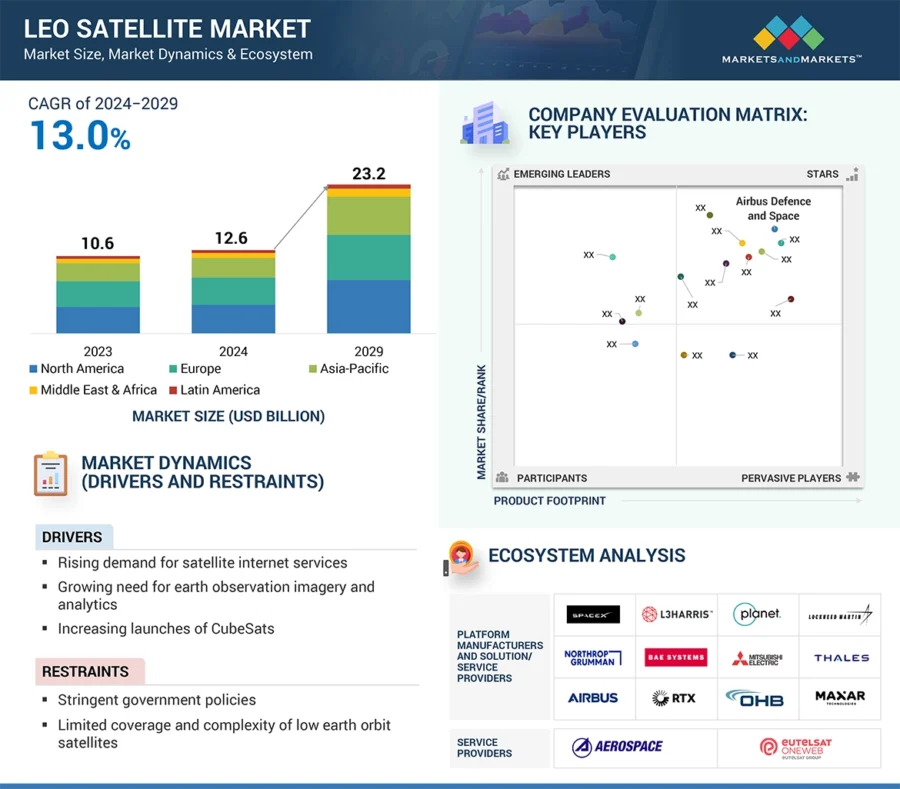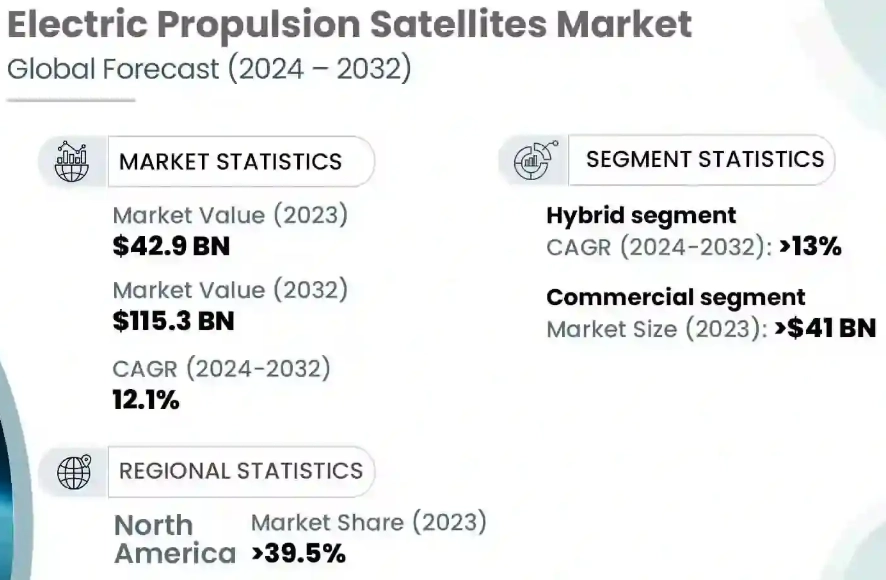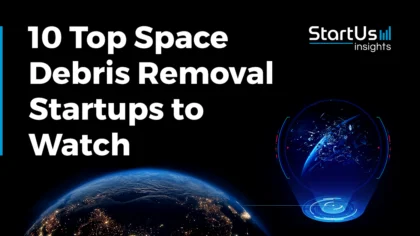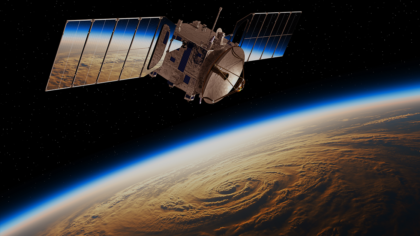The satellite technology trends in 2025 reflect the focus of the industry on sustainable space missions, improved in-orbit services, increased adoption, and better connectivity. Trends like low-earth orbit (LEO) networks, artificial intelligence (AI) integration, cubesats, and green satellites represent the area of interest for the satellite industry.
The satellite industry is set to grow at a compound annual growth rate (CAGR) of 12.3% from 2025 to 2030 and reach USD 35.95 billion by 2030. This report explores 10 emerging trends in the satellite industry along with 20 innovative startups advancing the sector.
What are the Top 10 Satellite Industry Trends in 2025?
- In-Orbit Services
- Satellite Internet of Things (IoT) & Edge Computing
- Cybersecurity
- Low-Earth Orbit (LEO) Networks
- Green Satellites
- CubeSats
- 5G and 6G Integration
- Inter-Satellite Links (ISL)
- Satellite-as-a-Service (SataaS)
- Onboard AI and Machine Learning (ML)
Methodology: How We Created the Satellite Industry Trend Report
For our trend reports, we leverage our proprietary StartUs Insights Discovery Platform, covering 7M+ global startups, 20K technologies & trends, plus 150M+ patents, news articles, and market reports.
Creating a report involves approximately 40 hours of analysis. We evaluate our own startup data and complement these insights with external research, including industry reports, news articles, and market analyses. This process enables us to identify the most impactful and innovative trends in the satellite industry.
For each trend, we select two exemplary startups that meet the following criteria:
- Relevance: Their product, technology, or solution aligns with the trend.
- Founding Year: Established between 2020 and 2025.
- Company Size: A maximum of 200 employees.
- Location: Specific geographic considerations.
This approach ensures our reports provide reliable, actionable insights into the satellite technology innovation ecosystem while highlighting startups driving technological advancements in the industry.
Innovation Map outlines the Top 10 Satellite Technology Trends & 20 Promising Startups
For this in-depth research on the Top Satellite Trends & Startups, we analyzed a sample of 3166 global startups & scaleups. The Satellite Technology Innovation Map created from this data-driven research helps you improve strategic decision-making by giving you a comprehensive overview of the satellite industry trends & startups that impact your company.

Tree Map reveals the Impact of the Top 10 Trends in Satellite Technology
The treemap reveals that the focus of the satellite industry is on sustainable operations, improved data transmission, and the expansion of satellite applications. Edge computing, IoT, ISL, and 5G and 6G integrations are improving the satellite connectivity, while green satellites are making space missions sustainable. LEO networks, cubesats, and in-orbit services are additionally improving satellite operations and ensuring longer mission lifespans.

Global Startup Heat Map covers 3166 Satellite Tech Startups & Scaleups
The Global Startup Heat Map showcases the distribution of 3166 exemplary startups and scaleups analyzed using the StartUs Insights Discovery Platform. It highlights high startup activity in the US and India, followed by the UK and Germany. From these, 20 promising startups are featured below, selected based on factors like founding year, location, and funding.

Want to Explore Satellite Industry Innovations & Trends?
Top 10 Emerging Satellite Industry Trends [2025 and Beyond]
1. In-Orbit Services
There are 7135 Starlink satellites in space as of 2025, and this number will only increase going forward. However, maintaining these satellites in space demands services like refueling, in-space manufacturing, traffic management, and more, which is why in-orbit servicing is a key trend in the satellite sector.
In-orbit services enable efficient and cost-effective operations by supporting maintenance within the orbit, reducing space debris, extending satellite lifespans, and enabling in-space construction.
They also make space operations safe by managing space traffic and preventing collisions between satellites and between satellites and debris.
The space industry uses robotic automation, autonomous navigation, modular and reconfigurable satellites, AI, mechanical grippers, and more for operations like refueling and repairing.
Japanese company Astroscale partnered with Indian companies Digantra and Bellatrix Aerospace to enable satellite end-of-life (EOLD) services and debris removal in the Asia-Pacific region. Further, the European Space Agency joined D-Orbit for their first in-orbit servicing mission.
ClearSpace develops an In-space Debris Removal Technology
Swiss startup ClearSpace provides in-orbit services to enable sustainable space operations with its ClearSpace-1 mission. The startup builds technologies that support various in-orbit services besides debris removal, including in-orbit assembly, manufacturing, repair, and recycling.
Hybrogines designs an Orbital Transfer Vehicle for Small Satellites
French startup Hybrogine builds Hyorbiter, an orbital transfer vehicle that provides in-orbit services for satellite deployment, maintenance, and sustainability. Hyorbiter is a flexible modular orbiter with hybrid rocket engines.
The transfer vehicle assists in satellite refueling and deorbiting to ensure mission flexibility and extend satellite lifespan. Its autonomous operation is suitable for individual missions and large-scale satellite constellations for commercial and government usage.
2. Satellite IoT & Edge Computing
Satellite IoT ensures connectivity in remote areas and solves terrestrial network challenges like spectrum congestion and expensive ground infrastructure maintenance. IoT also offers environmental monitoring to assist in climate change mitigation efforts.
At the same time, edge computing ensures real-time data processing and is essential for advanced space exploration.
Instead of transmitting IoT-generated data back to the earth for analysis, edge computing enables onboard data processing and analysis. This ensures faster decision-making, reduces data transmission cost and bandwidth usage, and enables real-time anomaly detection.
For example, Myriota Network offers direct-to-satellite IoT technology to facilitate mass data transmission to satellites. Further, Hewlett Packard Enterprise in Texas and Ames Research Center sent a radiation-hardened computer to space.
This approach is making fast, low-cost radiation hardening available to commercial space companies.
Additionally, Lockheed Martin built the SmartSat platform, which is used by its LM 400 satellites to perform onboard data processing. Further, Azure Orbital Cloud uses SpaceX’s Starlink connectivity and Azure Edge device to empower data transmission and processing.
The satellite IoT market size is set to reach USD 15.5 billion in 2034, growing at a CAGR of 23.1%. Additionally, the global space-based edge computing market is estimated to reach USD 1807.3 million in 2033, growing at a CAGR of 22.64% from 2023 to 2033.
Satlyt employs Interconnected Satellites for Edge Computing
US-based startup Satlyt provides an interconnected network of satellites that enables edge computing in space. Its proprietary technology features distributed processing and mesh communication for effective data processing and communication.
The satellite network is decentralized and offers distributed data processing and inter-satellite communication. The startup further provides isometric, federation, Earth orbit, and data flow views for visualizing satellite network architecture and data flow between nodes.
Rivir develops a Direct-to-Cellular IoT Satellite Gateway
New Zealand-based startup Rivir offers a direct-to-cellular IoT satellite gateway, Rivir R200. It connects industrial assets and sensor fleets using LWM2M IoT data protocol. This reduces data payload and eliminates the dependency on a stable end-to-end connection for data transmission.
The software layer of the core LwM2M ensures easy deployment along with the management of IoT and SCADA-powered assets and edge equipment. Its REST API further enables the integration of satellite IoT data networks with central business systems.
3. Cybersecurity
Countries use satellites to strengthen their defence and support the economy by forecasting and providing data to industries, like agriculture, mining, marine, and energy. Satellite cybersecurity solutions ensure this information is safeguarded from security threats.
Additionally, remotely controlled satellites rely on advanced encryption, including post-quantum cryptography, to conduct missions and protect assets from threats. Technologies, like quantum-resistant cryptography, AI, and zero-trust architectures (ZTA), are also improving cybersecurity for the space industry.
For example, the European Union (EU) has launched the infrastructure for resilience, interconnectivity, and security by satellite (IRIS). It is a GBP 10.5 billion project for deploying 290 satellites by 2027. Additionally, the European cybersecurity company CYSEC joined Viasat’s ELEVATE program for satellite encryption services.
Space Armour offers a Zero Trust Cybersecurity Mesh
Space Armor builds a zero-trust cybersecurity solution, Space AI Lab, for space systems and satellite networks. The solution features an AI-enabled, quantum-secure, space-based mesh network with fine-tuned language learning models (LLMs).
It extends ground-based AI capabilities to in-orbit systems with in-orbit intelligence. The autonomous space solution also offers blockchain-based digital identity, systems protection with SDP architecture, cross-network secured gateways, and immutable logs.
BitRezus builds a Cyber Security Platform for Space Assets
Greek startup BitRezus builds Astropledge, a cybersecurity platform for space assets. It is a cybersecurity space layer that monitors and prevents cybercrimes using smart contracts and blockchain stacks.
The platform comes with tokenized space assets, Opcodes, which are validated and verified using space light nodes. Further, the startup feeds these OpCodes into a smart contract to enable real-time monitoring.
4. Low-Earth Orbit Networks
LEO satellites are vital for global connectivity, closer earth observation (EO) with high resolution, and precise positioning. Low-power wide area network (LPWAN) and Ka and Ku-band technologies ensure connectivity among the satellites in LEO networks.
Further, edge computing improves data transmission and processing closer to the LEO satellite. AI controls the data path in LEO satellites, while integrating 5G and 6G into LEO networks makes it more future ready.
Orange and Telesat signed a multi-year partnership for Telesat Lightspeed LEO satellite connectivity and terrestrial infrastructure. Further, Viasat and Rocket Lab partnered to develop on-demand, low-latency data relay services for LEO satellites.
Additionally, NOAA built the near-Earth orbit network (NEON) program to develop LEO environments for satellites.
The LEO satellite market is set to grow at a CAGR of 13% and reach USD 23.2 billion by 2029.

Source: MarketsandMarkets
NewOrbit Space offers LEO Satellites for Global Connectivity and Insights
UK-based startup NewOrbit Space provides an ultra-LEO (ULEO) satellite, NEO1, for global connectivity and insights. The satellite utilizes an air-breathing electric propulsion, and offers better atmospheric data, image resolution, and data speeds without space debris.
The satellites also provide precise forecasts of hurricanes, wildfires, and floods by accessing atmospheric data. Additionally, it provides stable satellite internet all over the Earth. NEO1 has a long lifespan and accommodates both commercial and scientific missions.
OrbitalNerds builds an In-Orbit Relay Infrastructure
US-based OrbitalNerds provides uninterrupted connectivity to satellites in the LEO with a telemetry, tracking, and control (TT&C) system. It provides ease of access with a command line interface and minimizes sudden downtime, missed connections, and dropped signals.
The system integrates with pre-built satellites without modifications, provides relay connections with minimal power draw, and connects satellites across different protocols and systems. The space industry and satellite operators use the TT&C system to reduce latency, improve uptime, and deliver over-the-air (OTA) updates.
5. Green Satellites
Green satellites leverage eco-friendly design, like reusable and modular systems, renewable energy, space debris minimization, and more.
The European Space Agency (ESA) is working towards a zero-debris strategy, while NASA is developing sustainable space missions that do not use the Earth’s resources. Additionally, Indian space organizations are strengthening global partnerships to accelerate sustainable space developments and missions.
Eco-friendly propulsion systems further leverage water-based propulsion, green monopropellant, and ionic liquid propellant to ensure sustainable satellite operations.
For instance, the Indian Space Research Organization (ISRO) is working on eco-friendly solid propellant based on glycidyl azide polymer (GAP) as fuel and ammonium di-nitramide (ADN) as oxidizer.
The global electric propulsion satellite market is estimated to grow at a CAGR of 12.1% from 2025 to 2032. Electric propulsion reduces satellite fuel consumption by 90%.

Source: Global Market Insights
Additionally, reusable and modular satellites reduce the carbon footprint of space missions. Apart from improving cost efficiencies of space missions, reusable and modular satellites reduce the space debris and footprint caused by manufacturing newer satellites.
Modularity also improves assembly and ensures faster upgrades while enabling scalable space missions.
The reusable launch vehicles market is estimated to reach USD 2.7 billion by 2030, growing at a CAGR of 8.8% from 2024 to 2032.
As of 2024, SpaceX has used its reusable rocket Falcon 9 multiple times. This significantly reduced the carbon footprint of launches.
European Advanced Reusable Satellites (EARS), formed by partnerships among Consiglio Nazionale delle Ricerche (CNR), Technology for Propulsion and Innovation (T4I), UAB Kongsberg Nanoavionics (KNA), and more, is also researching and developing reusable satellites.
PERSEI Space offers Green Space Propulsion Solutions
Spanish startup PERSEI Space provides propellant-less solutions for in-space propulsion. They include PEARSON, an autonomous deorbiting satellite, GMM, a non-autonomous deorbiter, and a reboosting product for smaller satellites.
PERSEI Space also provides BETsMA V2.0, a mission analysis software that tracks and manages propulsive and power harvesting scenarios.
These solutions use electrodynamic tethers (EDT) for drag and thrust, which eliminates the requirement for a propellant. The EDTs interact with the ambient plasma and geomagnetic field in the space environment to create a force without any catalyst.
Aphelia provides mmWave Wireless Power Transmission (WPT)
Malaysian startup Aphelia enables long-term lunar explorations with its proprietary semiconductor chip. It is a radio frequency monolithic microwave integrated circuit (RF MMIC) made with GaN materials.
The chip assists in wireless energy transfer from the light side to the shaded side of the moon. It also allows offers high-powered beaming to lunar bases and rovers.
The semiconductor chip also enables energy-efficient and sustainable missions in dark craters and harsh environments.

6. CubeSats
The miniature design of cubesats enables faster development and deployment, lower fuel requirements for operations, and reduced cost of manufacturing and operations.
Propulsion technologies for cubesats include kinetic, chemical, and electric types of propulsion. Further, 3D printing enables customizable and cost-effective manufacturing of cubesats.
For power generation, cubesats integrate solar panels and secondary batteries for energy storage. Additionally, recent advances in cubesats include autonomous operations, improved communication and data transfer, constellation management, and deep space cubesats.
Planet Labs operates a fleet of Earth observation cubesats called Doves. Further, NASA selected 10 small research satellites to contribute to education and science opportunities, supporting technology advancements and providing workforce development.
In 2024, 4 cubesats from ESA returned to Earth after completing critical missions and contributing to future space technologies and scientific data return.
The CubeSat market is set to grow at a CAGR of 16.82% from 2023 to 2033. As of 2024, 2505 CubeSats have been launched.
2NDSpace manufactures High-Performance Modular CubeSat Structures
Italian startup 2NDSpace provides cubesat components for faster, flexible, and safer integration. The components include structural pieces, solar panels, deployable solar panels, power systems, communication systems, and test equipment.
The structural pieces come with a customizable aperture layout and are compatible with commercial components. The space-grade solar cells also have a zero-residual dipole design and a stabilized thermal dissipation architecture.
The deployable panels feature single or double configurable wing electrical connection, while the power systems have a custom payload power supply module. This provides a flexible and redundant BUS voltage supply.
2NDSpace’s communication system consists of deployable, low-profile UHF/VHF patch antennas with customizable frequency ranges and interfaces. Lastly, the test equipment offers a real-load environment simulation test pod with dimensional and inertial cubesat replica masses.
Capsule Corporation builds a Water-based SmallSat Propulsion System
Italian startup Capsule Corporation develops WaterCube, a plug-and-play water-based propulsion system for cubesats and smallsats. It is small in size, easy to integrate, and cost-effective.
The propulsion system uses an unpressurized water propellant, which makes it a sustainable and safe choice. The lightweight design makes it suitable for primary propulsion for cubesats and primary or secondary propulsion for smallsats.
The startup uses 3D printing to manufacture the system using off-the-shelf components. This makes the system modular, allows serial production, and ensures a short delivery time.
WaterCube is ideal for de-orbiting, collision avoidance, orbit maintenance, and formation flight. Smallsats exclusively use the system for altitude control and proximity operations.
7. 5G and 6G Integration
Satellites offering 5G and 6G networks provide coverage beyond terrestrial networks, improve connectivity in remote areas, enable low-latency and high-speed connections, and optimize backhaul services.
The telecommunication industry is expanding the usage of satellites to improve connectivity for mobile users.
Technologies like software-defined networks (SDNs), multi-tasking backhauling, and multi-access edge computing (MEC) enable streamlined integration of satellite infrastructure into 5G and 6G.
Bharat Airtel and Jio have partnered with SpaceX’s Starlink to provide high-speed 4G, 5G, and 6G internet to Indian customers. Further, ESA partnered with multiple mobile satellite service associations to improve 5G and 6G-based networks.
The satellite-based 5G network market is set to grow by a CAGR of 65.1% to reach USD 3.69 billion by 2028.

Source: MarketsandMarkets
Sateliot provides 5G Satellite Narrowband IoT
Spanish startup Sateliot launched a constellation of 5G satellites named 3B5GSAT, which enabled 5G non-terrestrial network (NTN) IoT connectivity over 3GPP standard narrowband IoT.
3B5GSAT also upgrades the uplink control and data channel design by increasing repetitions, estimating the joint channel, and hopping frequencies.
Additionally, Rel-17 introduces new radio technologies, including enhanced mobile broadband (eMBB) and ultra-reliable low latency communication (URLLC) for higher throughput, lower latency, and better communication.
Terrestar Solutions enables Commercial Deployment of 5G New Radio NTN
Canadian startup Terrestar Solutions supports the commercial deployment of 5G new radio non-terrestrial network. It addresses the challenges of service gaps and cellular dead zones in rural and remote areas with an operational satellite and open-network architecture.
The infrastructure consists of a geostationary satellite asset, Echostar T1, Canadian satellite ground network infrastructure, 3GPP standards infrastructure, and Canadian mobile satellite licences in the 2 GHz frequency band.
8. Inter-Satellite Links
Inter-satellite links directly share data with neighboring satellites to ensure effective data transmission while bypassing the ground infrastructure.
Radio frequency and laser-based optical communication (OISL) are two primary types of inter-satellite links. The global optical satellite communication market is set to grow by a CAGR of 24.14% from 2023 to 2033, and reach USD 4.07 billion in 2033.
Further, the satellite laser communication market is predicted to reach USD 36.4 billion by 2034, growing at a CAGR of 45.4%.
For instance, Starlink uses laser-based communication to enable inter-satellite links in space. Viasat develops real-time data links through inter-satellite links, which enable cost-effective data relay capabilities for lower Earth orbit operators.
Further, Starlink’s inter-satellite laser links recently transferred data at a record speed of 42 million GB per day. SpaceX is also developing satellite laser links for sale to other space-based companies.
Shangguang Communication offers Laser Communication for Inter-Satellite Links
Chinese startup Shangguang Communication develops stable laser communication terminal products for satellites. The products include the StarNet Laser Terminal processor, an amplifier, and an optical head.
The startup uses a coherent detection system to create an inter-satellite link between satellites within the same or different orbits. It provides high-speed data transmission between nodes of the space-bearer network.
The products further use internal pyramid return light for relative pointing monitoring of optical axis and a star director for accurate open-loop pointing. It additionally eliminates beacon tracking, which ensures faster reverse compound scanning.
It also offers precise inter-satellite distance measurement and clock error. The products ensure accurate ranging and time synchronization of the entire network.
Rivada Networks enables Point-to-Point Low Latency Orbital Network
German startup Rivada Networks builds Outernet, a constellation of satellites in LEO. This constellation uses optical space networking to ensure inter-satellite links and high throughput in orbit.
The ISL further provides high user-level security protocols. The startup uses variable quality of service (QoS) settings. Its regenerative payload is digital and ensures sufficient spectral efficiency and less interference at the satellite level.
Outernet constellation is autonomous and has a modular design. It comes with active phased arrays for active multibeam management, which allows reconfigurable coverage and variable radiated power.
The onboard router further assists with differentiated QoS and path finding. B2B customers and the government use the satellite constellation for low-latency connections.
9. Satellite-as-a-Service
Satellite-as-a-service allows business owners to use data and insights generated by satellites without owning satellites or investing in satellite manufacturing, launching, or maintaining.
Businesses use satellite data for various applications, like weather forecasting for global safety enhancement, and provide an overview of the adjacent situation from space. They also leverage insights from satellites to support connecting remote assets, situational forecasting, and disaster relief.
Satellites use LEO constellations, software-defined payload configurations, and mesh networks to offer high-throughput, low-latency global connectivity and data services.
SataaS is an evolving market that is estimated to reach USD 5.87 billion in 2025. It will further grow at a CAGR of 15.50% from 2025 to 2034.
National space organizations like ISRO and ESA provide satellite-based services to governments, including insights about defense, agriculture, mining, construction, and more. Further, Starlink by SpaceX offers high-speed, low-latency connectivity using a constellation of LEO satellites.
KOKO Forest provides Forest Ecosystem Insights using Satellites
Finland-based KOKO Forest provides satellite-based forest analytics and services. It provides information about forests using satellite technology, AI, and cross-disciplinary ecological know-how.
Its solution FOREST HEALTH provides information and analysis of the health and condition of forests using earth observation data and AI. Further, the FOREST RISK estimates the future climate risks using various climate scenarios, and FOREST DAMAGE offers damage training with information about harmful forest insect pests.
The satellites use sensor technologies on board, which enable the use of different parts of the electromagnetic spectrum apart from visible light for monitoring forests. The near real-time information collected allows sustainable management of forests.
Eartheye Space offers On-Demand Satellite Tasking & Insights-as-a-Service
Singapore-based Eartheye Space provides space-based information and insights, using the Eartheye platform, to the mining industry and the government. Multiple sensors on the satellite collect and provide data and information on time. Users choose whether they prefer a standalone sensor or combined sensors for multimodal data.
The startup also provides tasking-as-a-service with its Sat-Tasking platform that removes hindrances in the satellite data collection. It reduces human intervention in the tasking and makes continuous earth observation easy.
Eartheye Space also provides information as a service to its customers. The platform extracts information that the customers integrate into their workflow for critical decision-making.
10. Onboard AI and ML
Satellites produce a significant amount of data that may bottleneck the downlink capacity. Using onboard AI and ML, satellites provide efficient downlink capacity and enable real-time and onboard decision-making.
Onboard AI and ML also prevent delay with strategizing and enable autonomous in-space operations like refueling and maintenance.
Further, AI and ML increase space situational awareness (SSA) of the satellites with autonomous anomaly detection and recovery, earth observation, improved image analysis, navigation, and collision avoidance.
The AI market in space exploration is predicted to reach USD 5.8 billion in 2025 and grow at a CAGR of 30.5% from 2025 to 2029.
The European Space Agency and Realtra Space Systems Engineering are partnering to develop an AI-driven satellite failure detection system.
ESA also started a new project called Ciseres that enables rapid disaster response using AI-powered satellites. Further, ISRO is planning to launch a fleet of fifty new AI-powered satellites over the next five years.
Zaitra enables Onboard Data Processing
Czech Republic-based startup Zaitra offers onboard AI-powered automated products for satellites, which ensure cost-effective satellite operations and faster data access.
The products include SKAISEN, onboard object detection software, and SKAIDOCK, a space unified data processing unit. SKAISEN uses AI-based cloud screening to detect and mark cloud pixels. It addresses the challenge of limited bandwidth of downlinking and unnecessary information collection on satellites that delays the transmission of important data.
Satellite data providers, payload and sensor developers, satellite manufacturers, and mission operators use the information to filter out the unwanted noise before transmitting the data to Earth. Besides, it is also reusable, autonomous, and provides important information faster.
SkyServe offers Real-Time Space Insights using AI and Edge Computing
Indian startup SkyServe supports satellite operators in deploying AI-powered earth observation applications on board with STORM and SURGE.
STORM is a sensor-agnostic edge computing stack that consists of a Linux OS and middleware and designs workflows for the satellite. SURGE is a smart satellite builder, where the user chooses the sensor, selects the workflow, and adds logic as Python scripts. It uses edge computing and GeoAI model management to decrease cost, latency, and downlink demand, and maintain data quality and service capacity.
Government organizations, geospatial developers, and analytics providers use the products for scalable and sustainable space operations. They develop, test, calibrate, and deploy their satellites with their choice of sensors, connect them to onboard AI, and collect data as required.
Discover all Satellite Trends, Technologies & Startups
As the demand for global connectivity and sustainable operations increases, satellite companies will be integrating more small, modular, and lightweight systems. Additionally, the defense industry will use satellites for increased surveillance. Solar-powered satellites will also contribute to sustainable space missions. Quantum, laser, and direct-to-device communication will also gain importance in satellite technology.
The Satellite Industry Trends & Startups outlined in this report only scratch the surface of trends that we identified during our data-driven innovation & startup scouting process. Identifying new opportunities & emerging technologies to implement into your business goes a long way in gaining a competitive advantage.
![Discover the Top 10 Satellite Industry Trends & Innovations [2025]](https://www.startus-insights.com/wp-content/uploads/2025/04/Satellite-Industry-Trends-SharedImg-StartUs-Insights-noresize-420x236.webp)



![15 Top Defense Companies and Startups to Watch in Europe [2025]](https://www.startus-insights.com/wp-content/uploads/2025/03/Defense-Companies-in-Europe-SharedImg-StartUs-Insights-noresize-420x236.webp)





